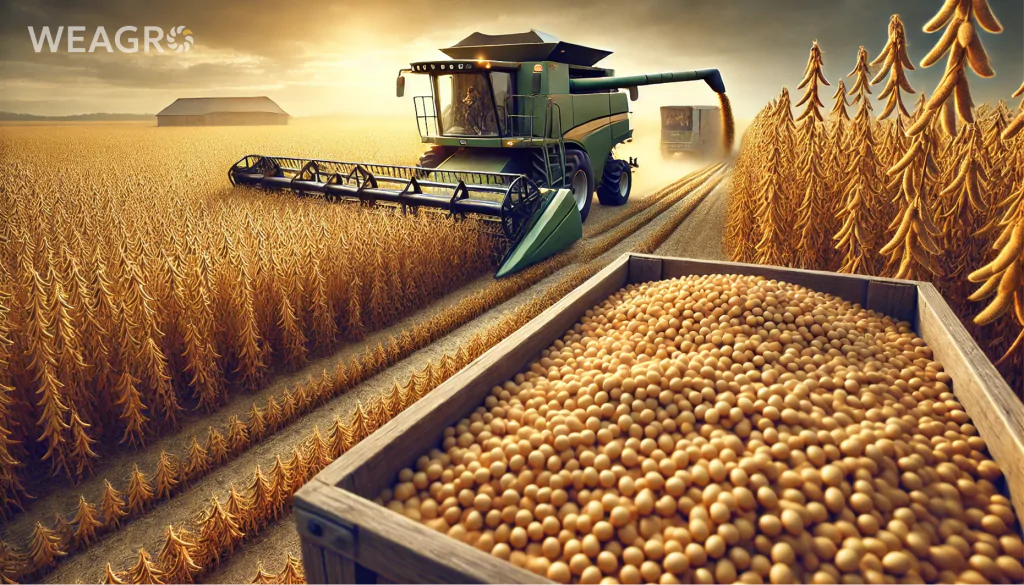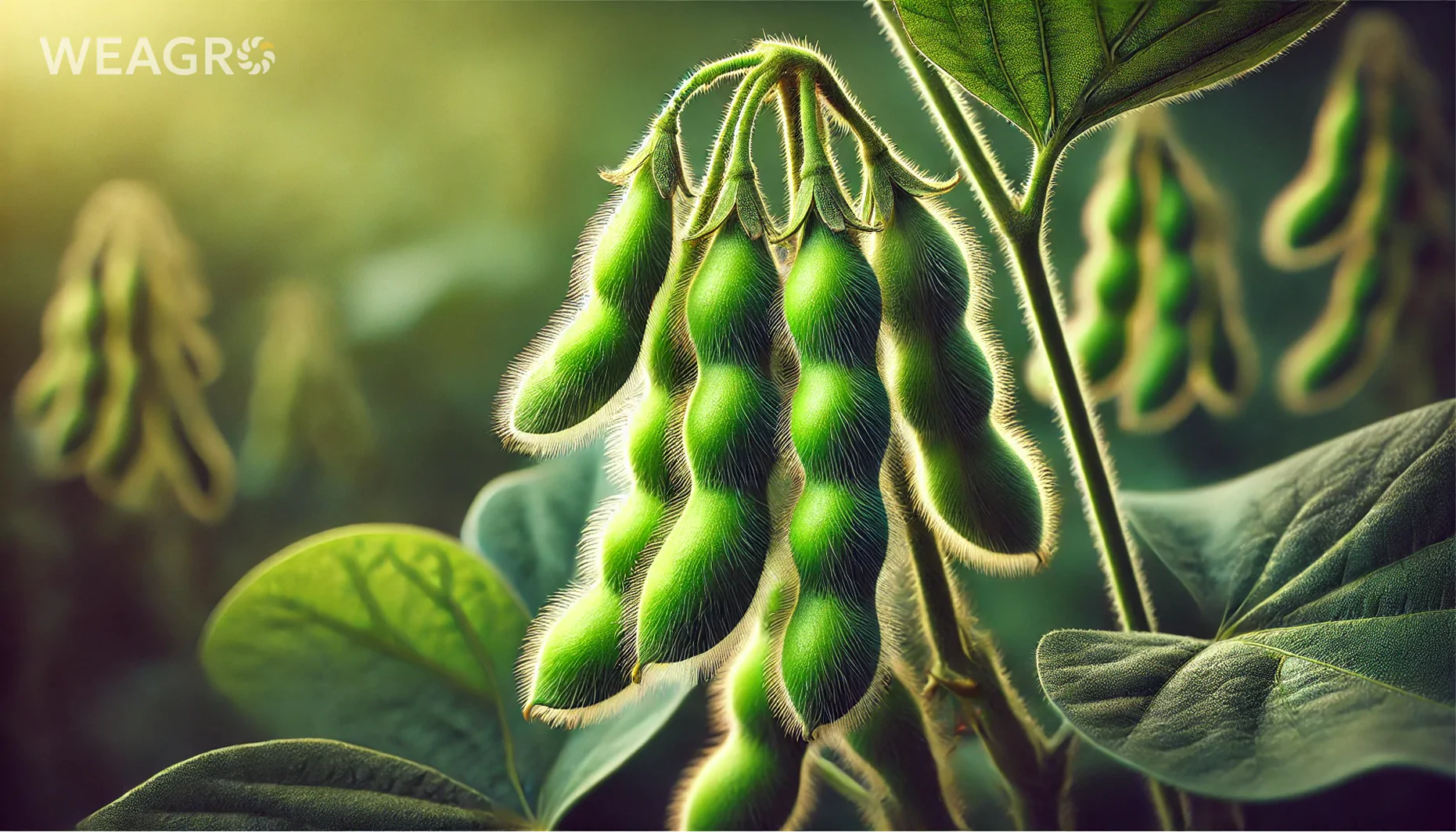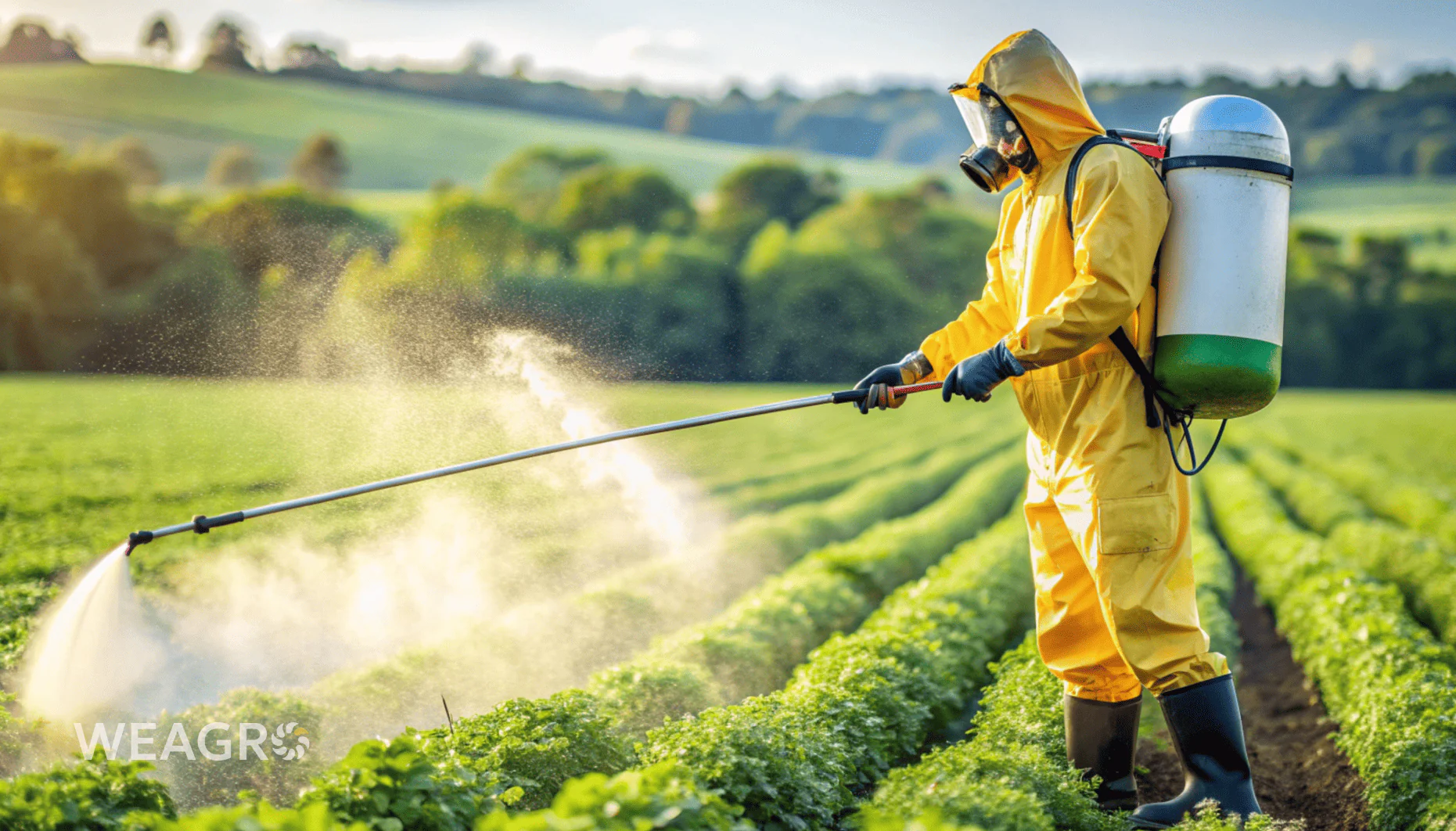Soybeans are one of the most important agricultural crops with stable demand in the global market. In Ukraine, the area under this crop increases annually, as it has export potential in crop rotations. According to State Statistics Service data, the sowing area in 2024 was 1,843.91 thousand hectares, and the Ministry of Agrarian Policy report for December of the same year indicated that 2,032.3 thousand hectares were sown with soybeans (102% of the plan).
To achieve high yields, it is important to follow recommended technology and know optimal parameters: from variety selection to harvesting. This article examines key aspects of cultivation, including seeding rates, expected soybean yield results per 1 ha, and best agrotechnical practices.
Soybeans: Crop Description
So, what are soybeans? This is an annual herbaceous plant of the legume family. It is a hardy crop that tolerates spring and autumn frosts down to 5°C well. The seeds consist of 50% protein, contain up to 25% fat and 1% lecithin. At temperatures of 20–22°C, it germinates in 4–5 days. What is made from soybeans? The crop is used to produce oil, soy milk, tofu, soy sauce, as well as animal feed.
Main phases of soybean development:
- seed germination;
- emergence;
- branching;
- budding;
- flowering;
- pod formation;
- seed filling;
- ripening.
The total duration of the vegetation period is 70–160 days, depending on the variety maturity group and weather conditions of the year. Each phase of plant growth and development has its optimal parameters for temperature regime, lighting and moisture supply.
Read also: What is seed germination: definition, how to check
Soybean Yield
Soybean yield in Ukraine varies depending on the growing region, variety, weather conditions and level of agricultural technologies. On average, the indicators for soybean yield per 1 ha are:
- in the Polissia zone — 1.4–2.2 t/ha;
- in the Forest-Steppe zone — 1.8–2.8 t/ha;
- in the Steppe zone — 1.2–2 t/ha.
With intensive technology, optimal water-temperature regime and favorable agrometeorological conditions, soybean yield per hectare on individual fields can reach 3.5–4.5 t/ha.
Soybean Cultivation Technology
To achieve high yields, it is important to follow the recommended soybean seeding technology per hectare, which includes variety selection, soil preparation, sowing, fertilization and protection systems, as well as timely harvesting.
Soybeans: Growing Conditions
In which climatic zone do soybeans grow? The crop thrives best in regions with humid and warm climate. Optimal for cultivation are zones where 400–760 mm of precipitation falls per year, and the vegetation period lasts 100–140 days. In Ukraine, fields are allocated for soybeans in practically all existing climatic zones, including:
- Polissia, where soils are more moistened;
- Forest-Steppe with fertile chernozems;
- South, where irrigation is used.
Soybeans grow well on structural, aerated soils with neutral or slightly alkaline reaction (pH 6.5–7). Acidic, saline and sandy soils are unsuitable for cultivation.
Read also: How to Determine Soil Acidity and How to Lower or Increase It
Soybeans: Sowing
Soybeans are a quite heat-loving crop, so they should be sown only when the soil is consistently warmed to 12–14°C at the seed embedding depth.
When to Plant Soybeans
So, when are soybeans sown? In southern regions, optimal timing falls at the end of April, in central and northern regions — early May.
Delayed sowing causes shortening of the vegetation period and yield reduction. But excessively early sowing dates in insufficiently warmed soil increase the duration of “sowing-emergence,” which leads to thinning of crops and seed disease damage.
Therefore, when determining optimal sowing dates, one should be guided not only by calendar dates, but also by actual weather conditions and temperature regime of soil and air, considering how soybeans grow in a specific region.
Soil Preparation for Soybean Sowing
Soil cultivation for soybeans can be traditional (plowing, cultivation) or minimal or zero tillage. Main cultivation objectives:
- creating a fine-crumbly structural seedbed layer;
- leveling the soil surface;
- destroying weeds and volunteer plants;
- activating biological processes in soil;
- accumulating and preserving soil moisture.
With traditional cultivation, in autumn the field is disked with disc implements to a depth of 6–8 cm, then plowed for winter fallow at a depth of 20–22 cm. In spring, moisture closure and soil leveling are conducted, and before sowing — pre-sowing cultivation to seed embedding depth with harrowing and rolling.
The feasibility of using zero or minimal tillage in soybean cultivation methods is determined by soil type, field weed infestation, presence of plant residues and climatic conditions of the region. However, generally, according to scientific research data, these cultivation methods do not reduce yield compared to traditional plowing under optimal crop rotation alternation conditions.
To improve the system, it is advisable to use innovative products and online services. WEAGRO offers farmers a convenient online service for obtaining installment payments on favorable terms for purchasing fertilizers, seeds, and plant protection products.
Soybean Predecessors
The best predecessors for soybeans are winter and spring grain crops, corn for silage and grain, sugar beets. It is recommended to return the crop no earlier than after 3–4 years. Can soybeans be sown after sunflower? There are significant limitations due to common diseases and soil depletion. Although modern technologies allow minimizing negative consequences, soybeans after sunflower are not recommended.
Read also: Sunflower diseases and pests: what exists and how to protect plants
Soybean Seeding Rate per 1 Ha in Kg
The soybean seeding rate per 1 meter depends on the variety maturity group, sowing method, seed weight and field germination. During cultivation, the indicator is determined in pcs./ha, considering the planned optimal plant density in the full emergence phase. To convert the rate from pcs./ha to kg/ha, the following formula is used:
H (kg/ha) = m (g) ⋅ n (thousand pcs./ha) ⋅ k / 1000,
where H — seeding rate, kg/ha; m — weight of 1000 seeds, g; n — planned plant density, thousand pcs./ha; k — coefficient accounting for seed field germination (usually 0.8–0.9).
Approximate seeding rates:
- 800–900 thousand pcs./ha — ultra-early;
- 550–600 thousand pcs./ha — medium-early;
- 450–500 thousand pcs./ha — medium-maturing;
- 350–500 thousand pcs./ha — late-maturing.
In drought conditions, the seeding rate is reduced by 20–25%, as crop thickening leads to excessive use of soil moisture. With sufficient moisture or under irrigation, the indicator can be increased by 10–15% to compensate for potential plant mortality.
Soybean Sowing Method
Soybeans are predominantly sown using the row method. For this, grain drills adapted for sowing row crops are used. Row spacing can be:
- for ordinary row sowing — 15 cm;
- for wide-row sowing — 45–60 cm;
- for precision sowing — 70 cm.
With ordinary row sowing, uniform plant density is created, ensuring efficient use of soil moisture and nutrients. Wide-row sowing allows inter-row cultivation and better weed control. Precision sowing with individual seed placement provides better illumination and air circulation in crops.
Seed embedding depth is differentiated depending on soil type and condition:
- heavy clay soils — 3–4 cm;
- light sandy loam — 4–5 cm;
- medium-textured soil — 4–6 cm.
For precise adherence to sowing depth, it is important to ensure uniform seed placement, which is achieved through optimal aggregate speed — no more than 10 km/h. Exceeding this indicator may cause material damage, reduced field germination and uneven emergence.
Soybean Care

For forming strong and healthy plants, proper care from emergence to harvest is important. The complex of agrotechnical measures includes:
- pre-emergence and post-emergence harrowing with light or medium harrows;
- application of soil herbicides before sowing or emergence;
- inter-row cultivation on wide-row crops;
- application of insurance herbicides in the 2–3 true leaf phase;
- foliar feeding with micronutrient fertilizers.
Protection against pests and diseases using an integrated system is also important.
When to Harvest Soybeans
Harvest timing depends on the variety maturity group and weather conditions in the pre-harvest period. Signs of crop readiness:
- browning of pods on plants of lower and middle tiers;
- leaf drop, except for top leaves;
- seed moisture no higher than 14–16%.
Harvesting begins when these signs are observed in 75–80% of plants in the crop. Optimal seed moisture for direct combining is 12–14%; with overstanding in the field, it may decrease to 10% or less, leading to pod cracking and losses.
Harvesting is conducted by direct combining within tight timeframes (7–10 days). Delays lead to grain quality deterioration, pod cracking and shattering. Plant cutting height should be no lower than 6–8 cm to maximally collect pods from the lower tier.
Post-harvest grain processing includes cleaning, sorting and drying. This allows bringing seeds to basic standards (moisture: 12%, trash impurity: 1–3%, debris impurity: 1–2%) and storing soybeans for 1–2 years without quality loss.
Soybean Varieties
Proper soybean variety selection is one of the determining factors for successful cultivation. In Ukraine, over 200 varieties of domestic and foreign breeding are registered, differing in vegetation duration, potential yield, seed quality, resistance to abiotic and biotic environmental factors.
When selecting soybean varieties for specific soil-climatic conditions, the following factors should be considered:
- Vegetation period duration. In Ukraine, varieties of 5 maturity groups are grown (ultra-early, early-maturing, medium-early, medium-maturing, late-maturing). Ultra-early varieties mature in 70–90 days and are suitable for northern regions, early-maturing — in 91–110 days, medium-early — in 111–120 days, medium-maturing — in 121–140 days, and late-maturing — over 140 days.
- Yield potential. For each region and growing zone, there is a certain optimum vegetation period duration that combines with maximum yield level. In drought conditions of the Steppe, early soybean varieties best realize productivity potential, in sufficiently moistened Forest-Steppe — medium-early and medium-maturing varieties.
- Seed chemical composition. The need for certain grain quality is determined by its intended use. When growing for food or feed purposes, high protein content (40–44%) and optimal fat content (18–22%) are important. When producing soybean oil, preference is given to high-oil varieties (22–24% fat).
- Lodging resistance. Tall soybean varieties form significant vegetative mass, leading to plant lodging, complicating care and harvesting. Therefore, for sufficient moisture conditions or under irrigation, it is better to use short or semi-dwarf varieties resistant to lodging.
- Disease and pest resistance. To reduce infectious load and crop protection costs, it is important to choose varieties with complex resistance to fusarium, downy mildew, bacterial blight, viral mosaic. The presence of resistance genes against acacia moth and other specialized pests is also a priority when selecting varieties.
Additionally, it is necessary to consider the direction of soybean grain use, seed price, crop rotation saturation with row crops. Optimal is sowing 3–4 varieties of different maturity groups, ensuring use of agroclimatic resources and crop insurance.
Characteristics of some best Ukrainian breeding varieties:
| Variety | Maturity group | Yield, t/ha | Protein content, % | Vegetation period, days |
| Ustya | early-maturing | 2.5–3.8 | 39–41 | 85–105 |
| Vilshanka | early-maturing | 2.3–3.6 | 38–40 | 90–105 |
| Khorol | medium-early | 2.8–4.2 | 39–42 | 105–115 |
| Georgina | medium-maturing | 3.0–4.5 | 38–41 | 115–125 |
| Romashka | medium-maturing | 2.6–4 | 37–40 | 115–125 |
Using modern high-yielding varieties in combination with optimal cultivation technology allows full realization of soybean genetic potential, achieving maximum economic effect.
Cost of Soybean Cultivation
Soybeans are a highly profitable crop but require significant production costs. The cost of cultivating soybeans per 1 ha in Ukraine is $300–500, depending on the intensification level. With yields of 2–2.5 t/ha and selling price of $400–450/t, profitability is 40–70%. So whether it is profitable to grow soybeans, each agricultural entrepreneur decides independently.
Read also: Production cost: what it is, calculation formula
Conclusion
Soybeans are a valuable high-protein crop of strategic importance for Ukraine. Following recommended cultivation technologies can achieve consistently high soybean yields — 3–4.5 t/ha. Key factors are:
- selection of adapted high-yielding varieties;
- optimal timing and sowing methods;
- effective fertilization and plant protection system;
- timely harvesting with minimal losses.
In the future, areas under soybean cultivation in Ukraine will grow considering high demand from local and external markets. Farmers should study innovative developments in breeding, modern crop monitoring technologies and precision agriculture. And purchasing equipment in installments without unnecessary documents is helped by the WEAGRO service, which connects entrepreneurs and sellers, allowing to receive money through future harvest. This enables agribusiness development and borrowers to receive goods without intermediaries and markups.









